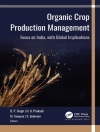Since the very first estimation on the abundance and role of microbial communities in the soil, researchers have attempted to assess distribution and functionalities of the species to correlate the entwining interactions between community structure and ecosystem function. Both culture-dependent and -independent approaches were worked out in deciphering and cataloging microbial diversity to investigate the linkage of microbial communities to the ecosystem function. The book Trends in Soil Microbial ecology presents holistic account of analyzing microbial communities and describing their functional role with increased understanding of their ecological significance in soils. While going through the book, the readers can generate a better understanding about the functional significance of microbial communities in soils (Chapter 1), application of functional metagenomics to uncover metabolic diversity of soil microbes (Chapter 2), role of soil microscale conditions to define spatial community distribution and function (Chapter 3) and CMEIAS computer-assisted microscopy for rhizobacterial colonization on roots (Chapter 4). Approaches for identification of soil microbial communities (Chapter 5) and applications of plant growth promoting rhizobacteria (Chapter 6) are described for readers interested in functional microbial diversity. Interesting topics like hydrolases activity for bio-indication of soil fertility in agro-ecosystems (Chapter 7), significance of endophytes (Chapter 8), microbial resources for crop improvement (Chapter 9), biological indicators for soil health (Chapter 10), arbuscular-mycorrhizal symbiosis for sustainable agriculture (Chapters 11 & 12), microbial biodiversity for soil health (Chapter 13) and biological options for crop health (Chapter 14) are covered to emphasize practically applicable issues on the most demanding research area of sustainable soil and plant health. Different microbiological parameters as soil quality indicators (Chapter 15) and rhizosphere engineering for crop under water stress (Chapter 16) are described to put before the readership a clearer picture of complex topics. Lastly, an attempt is made to let the readers understand analysis of the outcomes of metagenomics data using bioinformatics resources (Chapter 17). The views of the authors are authoritative, based on their long thorough research experience in the subject area and figures, schemes, tables, photographs and citations presented in the chapters make a better understanding of the subject.
Dhananjaya P. Singh & Harikesh B. Singh
Trends In Soil Microbial Ecology [EPUB ebook]
Trends In Soil Microbial Ecology [EPUB ebook]
Compre este e-book e ganhe mais 1 GRÁTIS!
Língua Inglês ● Formato EPUB ● Páginas 405 ● ISBN 9781626992023 ● Editora Studium Press ● Publicado 2014 ● Carregável 3 vezes ● Moeda EUR ● ID 7345847 ● Proteção contra cópia Adobe DRM
Requer um leitor de ebook capaz de DRM












